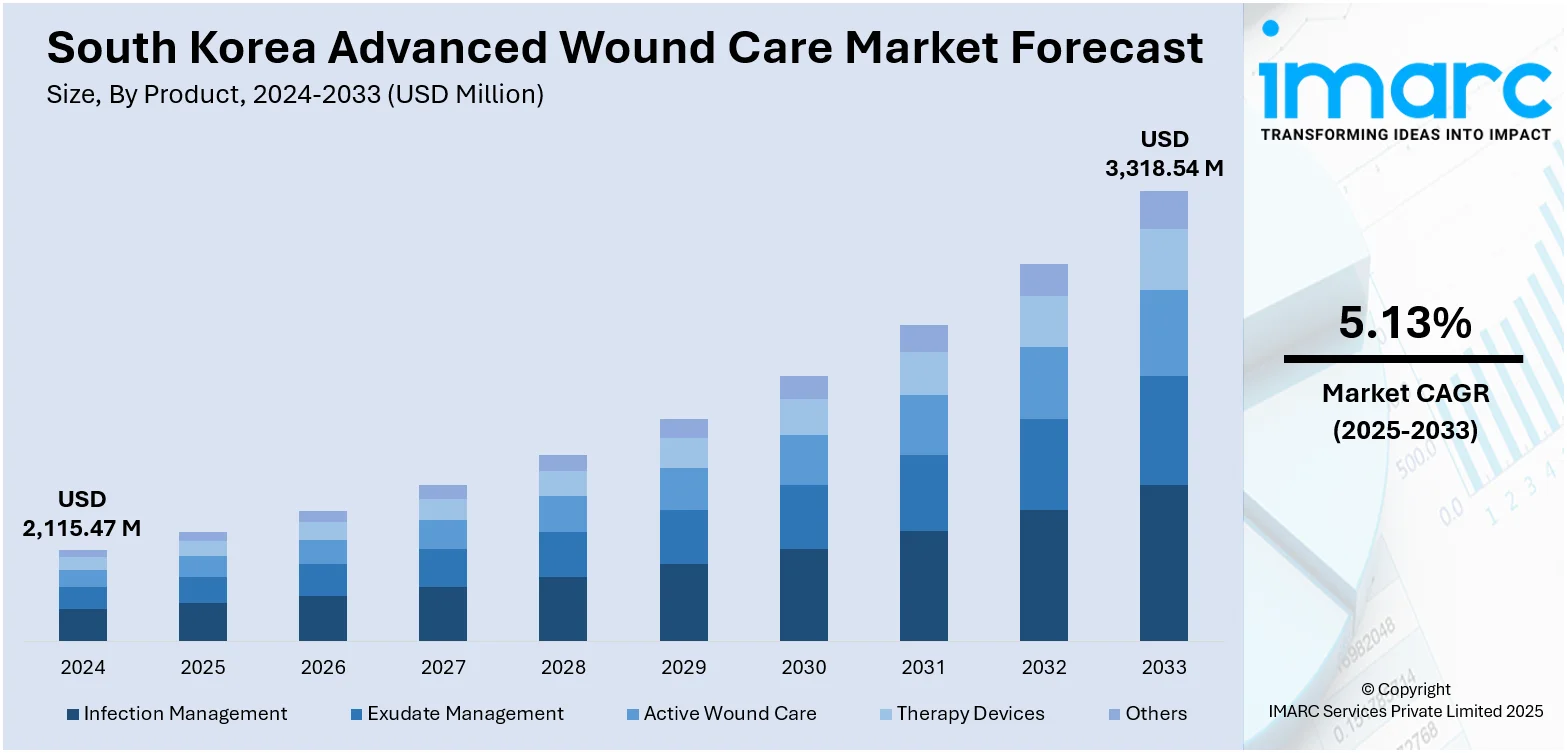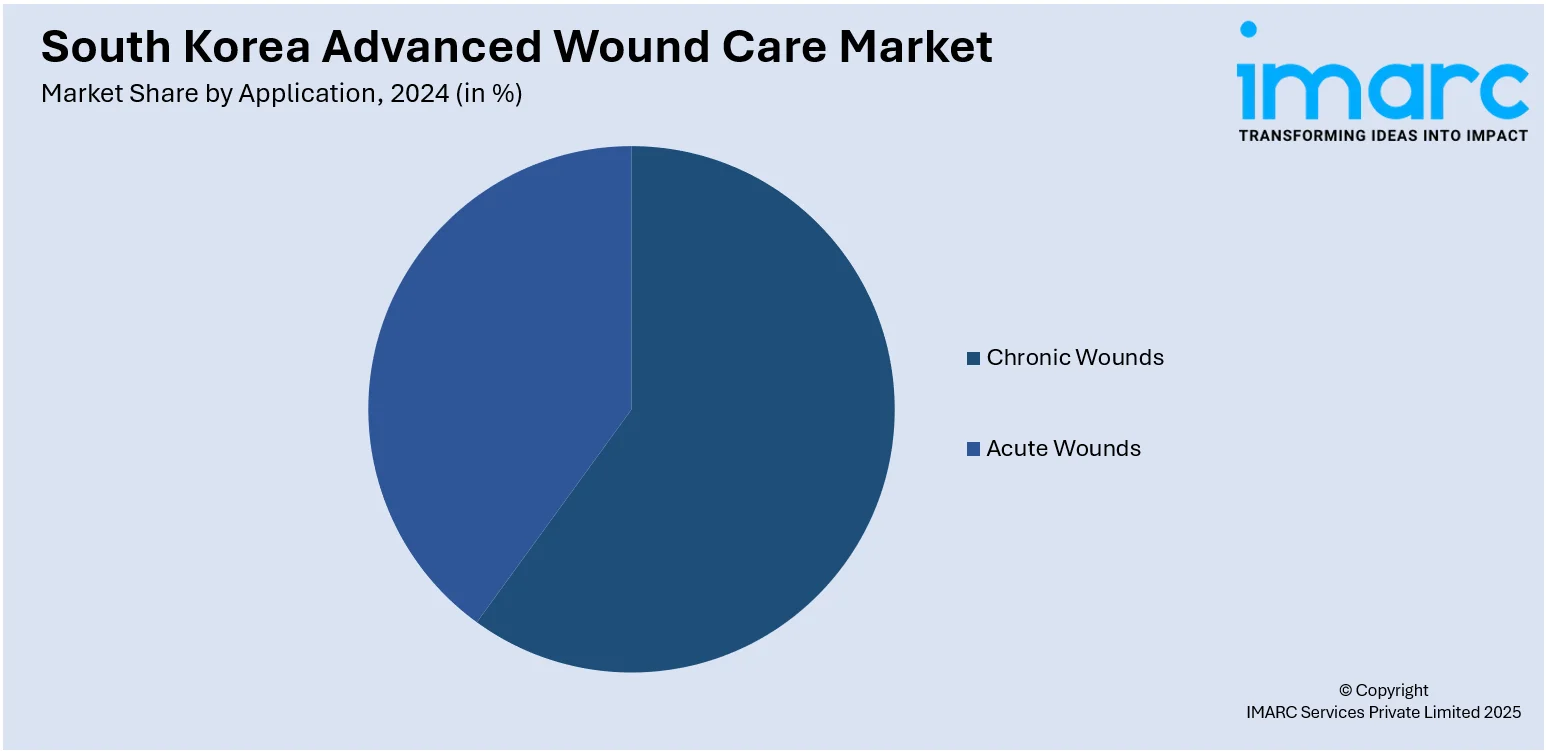
South Korea Advanced Wound Care Market Size, Share, Trends and Forecast by Product, Application, End User, and Region, 2025-2033
South Korea Advanced Wound Care Market Overview:
The South Korea advanced wound care market size reached USD 2,115.47 Million in 2024. Looking forward, IMARC Group expects the market to reach USD 3,318.54 Million by 2033, exhibiting a growth rate (CAGR) of 5.13% during 2025-2033. The increasing incidence of chronic diseases such as diabetes, cardiovascular diseases, and obesity in South Korea is driving the demand for sophisticated wound care products. Moreover, various technologies like hydrocolloid dressings, silver-based antimicrobial products, and bioengineered skin grafts are improving the wound healing process and patient comfort. Additionally, improvements in the healthcare infrastructure are expanding the South Korea advanced wound care market share.
|
Report Attribute
|
Key Statistics
|
|---|---|
|
Base Year
|
2024
|
|
Forecast Years
|
2025-2033
|
|
Historical Years
|
2019-2024
|
| Market Size in 2024 | USD 2,115.47 Million |
| Market Forecast in 2033 | USD 3,318.54 Million |
| Market Growth Rate 2025-2033 | 5.13% |
South Korea Advanced Wound Care Market Trends:
Increasing Incidence of Chronic Ailments and Age-Related Complications
The rising occurrence of chronic diseases like diabetes, cardiovascular diseases, and obesity in South Korea is driving the demand for sophisticated wound care products. Chronic diseases such as diabetes tend to result in complications like diabetic foot ulcers, which need expert management of wounds. The Korean Diabetes Association (KDA) has created the 2025 Diabetes Clinical Practice Guidelines to offer evidence-supported advice for diagnosing, screening, preventing, and treating diabetes along with its complications. South Korea's growing aging population only accentuates this trend, with older people being more prone to developing conditions that contribute to chronic wounds, such as pressure ulcers and venous ulcers. South Korea's National Statistical Office reports that the elderly population is rising considerably, thereby increasing demand for sophisticated wound care products and technologies. As age-related diseases and chronic conditions remain a threat, hospitals and healthcare systems demand sophisticated wound care products such as dressings, skin substitutes, and bioactive products to efficiently treat such conditions and enhance patient outcomes.

To get more information on this market, Request Sample
Technological Advancements in Wound Care Products
Wound care technologies are revolutionizing the treatment process in South Korea. Advanced wound care technologies like hydrocolloid dressings, silver-based antimicrobial products, and bioengineered skin grafts are improving the wound healing process and patient comfort. These products promise advantages like shorter healing time, minimization of infection risk, and less painful treatment. The inclusion of intelligent technologies, such as sensors for tracking the status of wounds and healing, is supporting the South Korea advanced wound care market growth. Furthermore, regenerative medicine developments, including the application of stem cells to heal wounds, are increasingly being understood and applied. As such innovations gain momentum, they are likely to create an increased demand for innovative wound care solutions, drawing the attention of healthcare professionals and patients seeking efficient and less invasive treatment choices. In 2024, the Wound Meeting Seoul took place, where experts from around the world gathered to discuss and highlight the upcoming and latest research in wound-associated fields.
Expanding Healthcare Infrastructure and Investment
The growth of South Korea's healthcare infrastructure, combined with rising investments in healthcare technology, is a major driver of the market. South Korea has an established health care system, which is bolstered by the government's favorable emphasis on healthcare innovation and technological incorporation. Investments in high-end medical equipment, innovative wound care treatments, and specialized health facilities are yielding improved wound management results. In addition, the private healthcare industry is proactively integrating advanced wound care treatments into its portfolio, with a view to addressing the increasing patient demand for improved solutions. This strong healthcare ecosystem promotes the uptake of new wound care products, with hospitals and clinics looking to enhance the quality of care being delivered to patients with complex and chronic wounds. IMARC Group predicts that the South Korea population health management market is projected to reach USD 6,575.6 Million by 2033.
South Korea Advanced Wound Care Market Segmentation:
IMARC Group provides an analysis of the key trends in each segment of the market, along with forecasts at the country and regional levels for 2025-2033. Our report has categorized the market based on product, application, and end user.
Product Insights:
- Infection Management
- Silver Wound Dressings
- Non-silver Dressings
- Collagen Dressings
- Exudate Management
- Hydrocolloids Dressings
- Foam Dressings
- Alginate Dressings
- Hydrogel Dressings
- Active Wound Care
- Skin Substitutes
- Growth Factors
- Therapy Devices
- Negative Pressure Wound Therapy (NPWT)
- Oxygen and Hyperbaric Oxygen Equipment
- Electromagnetic Therapy Devices
- Others
The report has provided a detailed breakup and analysis of the market based on the product. This includes infection management (silver wound dressings, non-silver dressings, and collagen dressings), exudate management (hydrocolloids dressings, foam dressings, alginate dressings, and hydrogel dressings), active wound care (skin substitutes and growth factors), therapy devices (negative pressure wound therapy (NPWT), oxygen and hyperbaric oxygen equipment, and electromagnetic therapy devices), and others.
Application Insights:

- Chronic Wounds
- Pressure Ulcers
- Diabetic Foot Ulcers
- Venous Leg Ulcers
- Arterial Ulcers
- Acute Wounds
- Burns and Trauma
- Surgical Wounds
A detailed breakup and analysis of the market based on the application have also been provided in the report. This includes chronic wounds (pressure ulcers, diabetic foot ulcers, venous leg ulcers, and arterial ulcers) and acute wounds (burns and trauma and surgical wounds).
End User Insights:
- Hospitals
- Community Health Service Centers
The report has provided a detailed breakup and analysis of the market based on the end user. This includes hospitals and community health service centers.
Regional Insights:
- Seoul Capital Area
- Yeongnam (Southeastern Region)
- Honam (Southwestern Region)
- Hoseo (Central Region)
- Others
The report has also provided a comprehensive analysis of all the major regional markets, which include Seoul Capital Area, Yeongnam (Southeastern Region), Honam (Southwestern Region), Hoseo (Central Region), and others.
Competitive Landscape:
The market research report has also provided a comprehensive analysis of the competitive landscape. Competitive analysis such as market structure, key player positioning, top winning strategies, competitive dashboard, and company evaluation quadrant has been covered in the report. Also, detailed profiles of all major companies have been provided.
South Korea Advanced Wound Care Market Report Coverage:
| Report Features | Details |
|---|---|
| Base Year of the Analysis | 2024 |
| Historical Period | 2019-2024 |
| Forecast Period | 2025-2033 |
| Units | Million USD |
| Scope of the Report |
Exploration of Historical Trends and Market Outlook, Industry Catalysts and Challenges, Segment-Wise Historical and Future Market Assessment:
|
| Products Covered |
|
| Applications Covered |
|
| End Users Covered | Hospitals, Community Health Service Centers |
| Regions Covered | Seoul Capital Area, Yeongnam (Southeastern Region), Honam (Southwestern Region), Hoseo (Central Region), Others |
| Customization Scope | 10% Free Customization |
| Post-Sale Analyst Support | 10-12 Weeks |
| Delivery Format | PDF and Excel through Email (We can also provide the editable version of the report in PPT/Word format on special request) |
Key Questions Answered in This Report:
- How has the South Korea advanced wound care market performed so far and how will it perform in the coming years?
- What is the breakup of the South Korea advanced wound care market on the basis of product?
- What is the breakup of the South Korea advanced wound care market on the basis of application?
- What is the breakup of the South Korea advanced wound care market on the basis of end user?
- What is the breakup of the South Korea advanced wound care market on the basis of region?
- What are the various stages in the value chain of the South Korea advanced wound care market?
- What are the key driving factors and challenges in the South Korea advanced wound care market?
- What is the structure of the South Korea advanced wound care market and who are the key players?
- What is the degree of competition in the South Korea advanced wound care market?
Key Benefits for Stakeholders:
- IMARC’s industry report offers a comprehensive quantitative analysis of various market segments, historical and current market trends, market forecasts, and dynamics of the South Korea advanced wound care market from 2019-2033.
- The research report provides the latest information on the market drivers, challenges, and opportunities in the South Korea advanced wound care market.
- Porter's five forces analysis assist stakeholders in assessing the impact of new entrants, competitive rivalry, supplier power, buyer power, and the threat of substitution. It helps stakeholders to analyze the level of competition within the South Korea advanced wound care industry and its attractiveness.
- Competitive landscape allows stakeholders to understand their competitive environment and provides an insight into the current positions of key players in the market.
Need more help?
- Speak to our experienced analysts for insights on the current market scenarios.
- Include additional segments and countries to customize the report as per your requirement.
- Gain an unparalleled competitive advantage in your domain by understanding how to utilize the report and positively impacting your operations and revenue.
- For further assistance, please connect with our analysts.
 Request Customization
Request Customization
 Speak to an Analyst
Speak to an Analyst
 Request Brochure
Request Brochure
 Inquire Before Buying
Inquire Before Buying




.webp)




.webp)












